The red panda (Ailurus fulgens) is an adorable, crimson-colored animal that lives in the eastern Himalayas and western China. They are actually more closely related to bears than to giant pandas, which is why they share a similar coloring and habitat preference.
- Status: Endangered
- Known as: Red Panda, lesser panda, and firefox.
- Estimated numbers left in the wild: Less than 10,000 adults.
Red pandas eat mostly bamboo but also enjoy eating eggs, insects, and small mammals like mice and hares. The pandas can also be found in zoos across the world where they’re very popular with visitors.
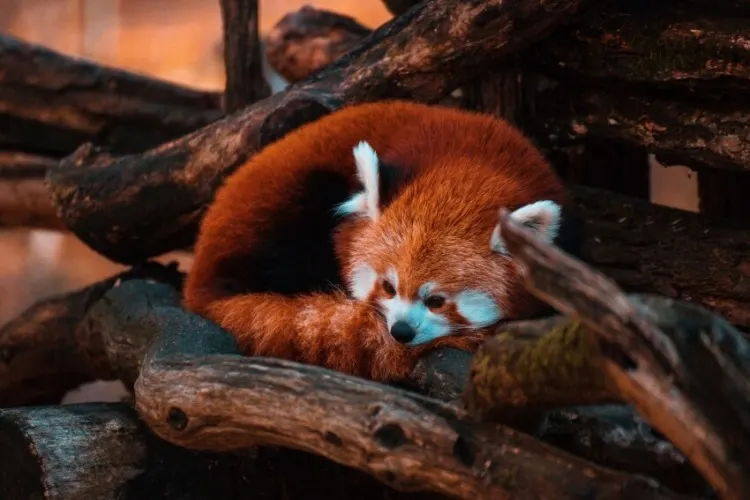
They have been living on Earth for over 2 million years! They’ve even been seen running through the streets of Beijing! These pandas have not been endangered at all so far because the Red panda population has remained steady at around 10 thousand throughout the past decade or so.
Description
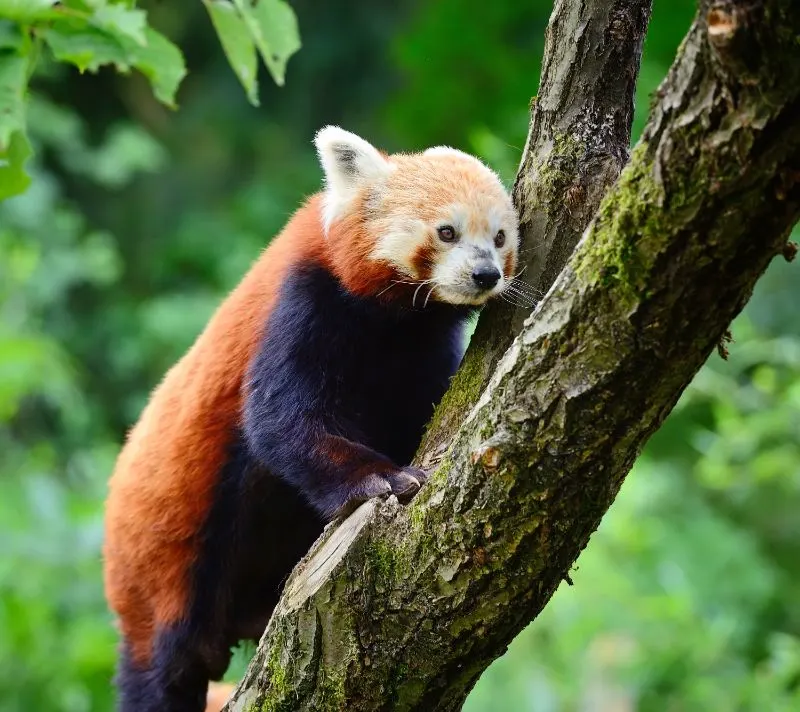
Red pandas are the only living member of its taxonomic family. They are plant-eating animals, adorable, crimson-colored animals that live in the eastern Himalayas and western China.
They are actually more closely related to bears than to giant species of pandas, which is why they share a similar coloring and habitat preference. This species eats mostly bamboo but also enjoys eating eggs, insects, and small mammals like mice and hares. They can also be found in zoos across the world where they’re very popular with visitors.
Crepuscular and nocturnal, they sleep the daylight hours away high in the branches, wrapped snugly in their bushy tails, before awakening to forage when the sun sets, and the light dims. They are often referred to as the red bear cat. The western red panda is a subspecies of this wonderful animal.
Anatomy and Appearance
Though the red panda’s coat – marked very handsomely in russet, black, and white – might appear to be decorative, it is in fact camouflage for this small mammal’s habitat, where red moss and white lichen cling to the moist tree branches. They also have sharp claws.
These arboreal (tree-dwelling) creatures are the size of a stocky domestic cat, weighing 3 to 6 kilograms and measuring 50 to 60 centimeters long. Both sexes are approximately the same size.
Their large, fluffy bushy tails, striped in white and red, provide balance in the trees and can be wrapped over the animal in cool or cold weather for warmth and protection from the elements.
They eat bamboo frequently – and, in fact, have a special wrist-bone projection to help grip bamboo shoots – but have a more varied diet than their distant cousins, the giant pandas. They will also rob birds’ nests for the eggs and eat birds’ eggs, eat flowers, bark, grass, and mushrooms, and consume leaves and berries.
They walk with a distinctive waddle on the ground thanks to their short front hind legs but are far more agile in the trees where these animals spend most of their lives. They have a low, sloth-like metabolism due to the inferior nutritive qualities of bamboo.
Location
Red pandas are found in China, Tibet, India, Bhutan, Nepal, and Myanmar. They live on cool, temperate slopes with dense bamboo forest supplying their main food.
Rainy, mountainous areas are their preferred habitat, and they remain in these areas throughout the winter, too. They cannot live in the lowlands since moderate heat is dangerous to them.
Behavior
Red pandas are solitary creatures and meet only briefly to mate before parting again. Young red pandas are born in nests prepared by their mothers inside hollow trees or in rock crevices. Each typical female red panda builds several of these nests so that the young pandas can be moved regularly between them.
Occasionally, a male will stay around to help care for his offspring, but most do not. They are fully mature in around two years and can live as long as 15 years, though most seem to live for eight to ten, assuming they do not fall victim to humans or other predators.
See Related: Greater Bamboo Lemur
Red Panda Habitat
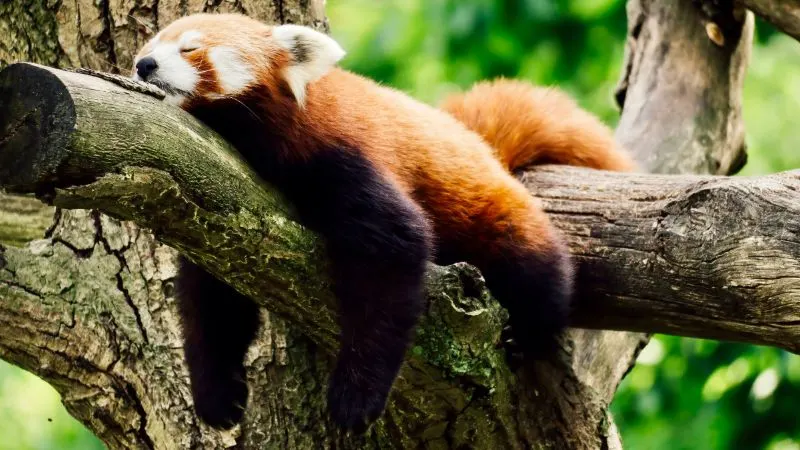
Red pandas live in the eastern Himalayas and western China. Red pandas are also good climbers and can be found up in the trees as well as on the ground. Red pandas are very adaptable animals and can live in different types of habitats, but they prefer forests that have plenty of bamboo.
Red Panda Diet and Nutrition
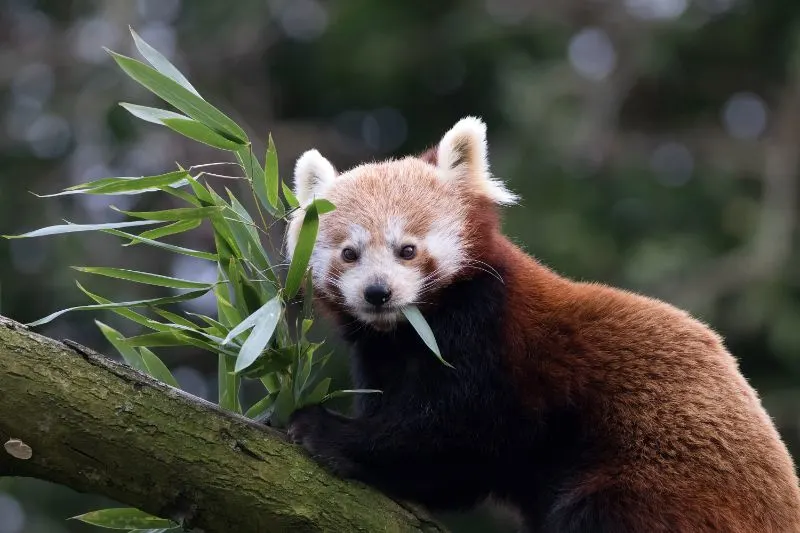
Red pandas are primarily herbivores and plant-eating animals but they also consume small rodents and bird eggs in the wild. Pandas eat around 27 pounds of bamboo per day and spend up to 13 hours a day eating.
They in zoos eat a variety of foods and live in habitats that provide them with the food and space they need to maintain their natural diet. Pandas may be fed bamboo, leaves, cakes, carrots, apples, bananas, grapes, corn kernels, pumpkin seeds, and other snacks/foods.
They may also be provided with leaves for chewing or scratching. These panda species rarely drink water so it is important for them to get enough moisture from their food and drinks like fruit juice.
Red Panda Mating Habits
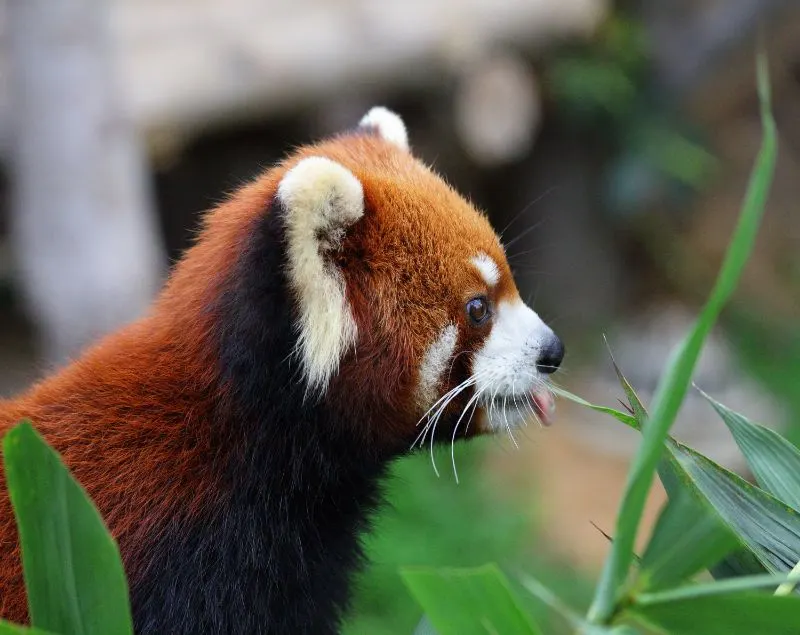
Typically male and female Red Pandas are solitary animals, but they can come together to mate. Female red pandas have only one litter every two years, but males have the capability to mate with several females in just a month or two.
Pandas breed and have an interesting mating system where the female will guard the male territory. When she is ready to mate, she will send out a mating call that will notify other females in the area of her readiness and also attract males. They are unique in that they mate while hanging from a tree branch.
They will mate with several different partners during mating season, which is why it is likely to see pandas around the same time even if they’ve been born more than 50 miles apart.
These pandas give birth between January and March. They usually have twins, but only the female panda will raise them.
Red Panda mothers are very attached to their cubs from day one; they carry their young ones on their backs most of the time until they are older. They do not leave their young unattended until they are about six months old.
Role in the Ecosystems
Red pandas serve a very important role in the ecosystem by eating bamboo, which is a plant that is not only a problem for humans but for other animals as well.
They are important for the environment because their impressive size and diet mean that they eat a ton of bamboo leaves each day.
These pandas help to keep bamboo forests healthy by eating the plant’s new sprouts, which is crucial for preventing wildfires and growing healthy tree canopies. They also predate on lizards, mice, and other critters living in or near these forests so their presence helps with pest control as well.
Red Panda vs Giant Panda

Here is the difference between red and Ginat panda. Red pandas and giant pandas are both bears, but they are different species and both endangered. Red pandas are smaller than giant ones, and they have reddish-brown fur.
They live in the eastern Himalayas and western China, while giant pandas live in central China. Red pandas mostly eat bamboo, while giant pandas eat mostly bamboo and also eat other types of plants. Red pandas can be found in zoos around the world, while giant pandas are only found in zoos in China.
Red and giant pandas also have different habitats. Red pandas live in temperate forests, while giant pandas live in subtropical forests. Red appears to be safe for now, but giant pandas are endangered.
Red Panda and Human Relationship
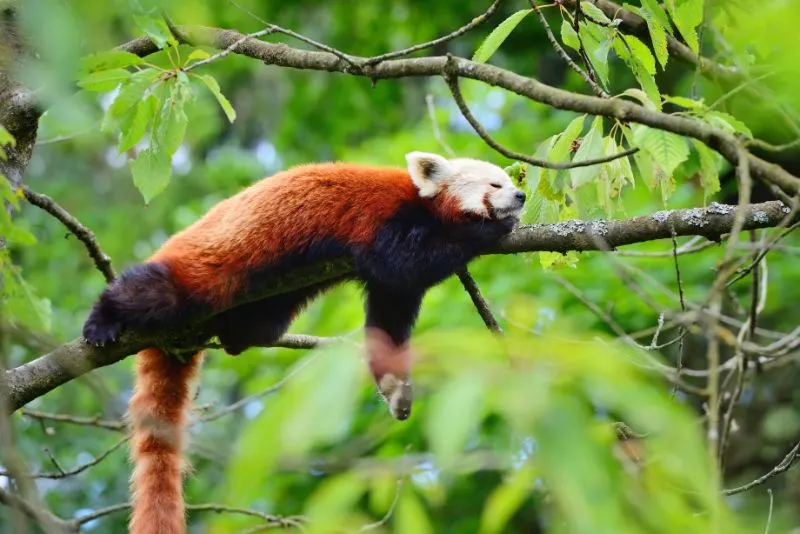
They’re not typically comfortable around humans, which is why they’re not often found in zoos. However, some people have been able to form close relationships with pandas, and these interactions can be very special. They that have been accustomed to humans can often be very playful and loving, and it’s always a treat to see one in person.
Predator
The primary predator of pandas is the leopard. Pandas are also preyed upon by the snow leopard and the clouded leopard.
They are adept at climbing trees, so they’re able to avoid most predators, but if they are caught on the ground they can be vulnerable. They have also been known to fight back against predators and can deliver powerful bites.
Population
Red pandas are endangered because they have a low population and limited range. Red pandas can be found in zoos across the world, but there is only a small population of Pandas living in the wild.
This plant-eating animal is an endangered species that depend on bamboo forests to survive. They also have a habitat that remains warm year-round which means that they need to find warmth somewhere else during colder months.
Red panda populations are declining faster as humans clear more and more forested areas each day, as well as climate change, affects their habitats.
Red Panda Facts
Here are the fascinating facts you need to know about these notable species.
- They are a mammal species that lives in the eastern Himalayas and western China.
- These panda species are related to bears and share similar coloring and habitat preferences.
- They eat mostly bamboo but also enjoy eating eggs, insects, and small mammals like mice and hares.
- They are pandas that can also be found in zoos worldwide where they’re very popular with visitors.
- Species are related to bears, so they share similar coloring and habitat preferences.
- They eat mostly bamboo but also enjoy eating eggs, insects, and small mammals like mice and hares.
- Species can also be found in zoos worldwide where they’re very popular with visitors.
- They are a mammal species that live in the eastern Himalayas and western China.
- These species are related to bears and share similar coloring and habitat preferences.
- The species mostly bamboo but also enjoy eating eggs, and insects
Are red pandas unique important and endangered?
Red pandas are a unique and important species due to their ecological significance and cultural value. They are considered a flagship species for the Eastern Himalayas, playing a vital role in maintaining the region’s biodiversity. Unfortunately, red pandas are also endangered due to habitat loss, poaching, and climate change. Conservation efforts are underway to protect these charismatic animals and their habitats.
See Related: Environmental Organizations in India
Conservation Status
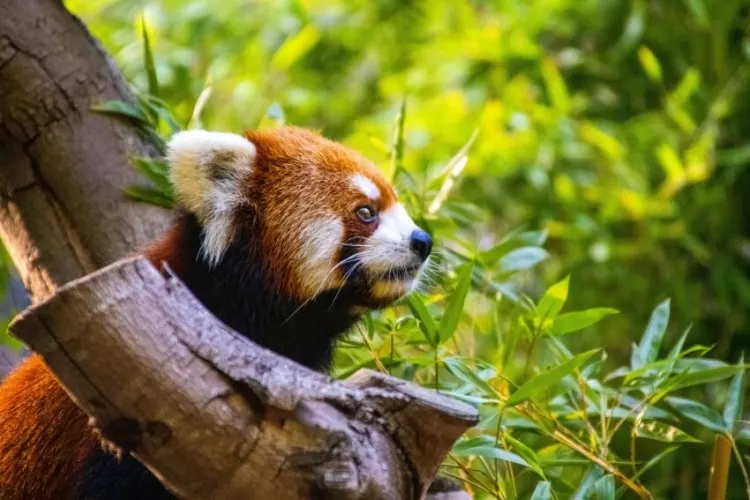
Threats
Red pandas are Hunted and poached for the supposed medicinal qualities of their various body parts. These animals are still killed to make “lucky” hats for weddings.
The biggest menace looming in the red panda’s near future is deforestation and habitat fragmentation due to logging and the spread of farming. Populations are becoming scattered and isolated, leading to the risk of losing viability and perhaps dying out due to inbreeding.
See Related: Why Is Biodiversity Important to Ecosystems
Conservation efforts
The red panda is under official government protection nearly everywhere throughout its range, except Myanmar, though enforcement is often quite weak. A network of zoos around the globe is undertaking a captive breeding program for future reintroduction efforts.
Even more, attempts to create a safer future for the panda are planned, particularly by the Mustelid, Viverrid, and Procyonid Specialist Group of the IUCN.
Wildlife corridors to link fragments of habitat, detailed studies of red panda distribution for effective placement of new reserves, and more captive breeding are planned or recommended.
Captive breeding
The Red Panda is one of the most popular animals in zoos around the world. They are found in captivity in many different locations.
One of the primary reasons for this is that pandas are relatively easy to breed in captivity. In fact, a captive breeding program was established by the Red Panda Network in 2006. This program has been successful in increasing the population of these pandas both in zoos and in the wild.
Research Program
The Research Program is a research and panda conservation initiative that is working to protect pandas and their habitat.
The Red Panda Research Program is working to gather information about Pandas in order to help protect them from an extremely high risk of extinction.
Organizations
Red Panda Network

Red Panda Network is an organization dedicated to the conservation of red pandas in the wild. Their main aim is to educate the local communities to protect the species.
Red Panda Network is a conservation organization that focuses on the red panda species. The panda organization has many projects to help protect their natural habitat including “planting bamboo for the pandas to eat” and “building watchtowers so people can report poaching.”
Final Thoughts
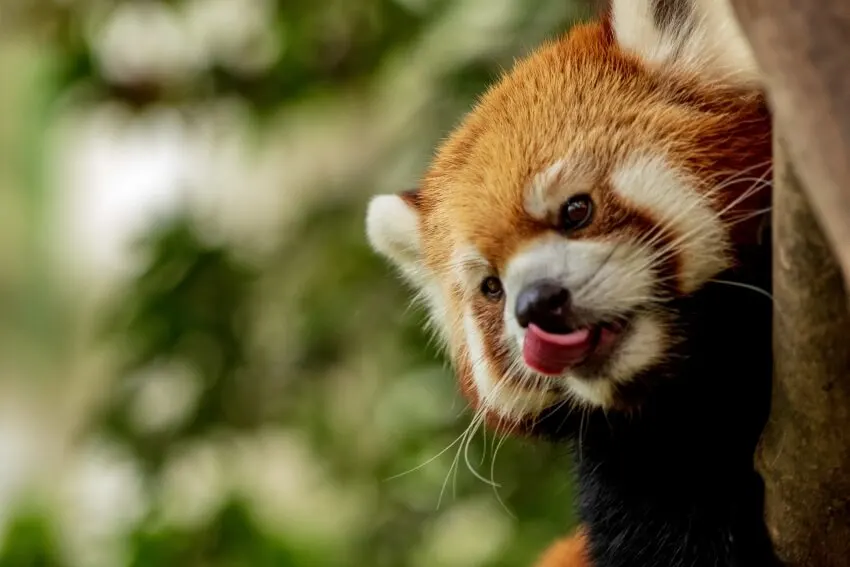
Red pandas known as red cat bears are a species of mamma and the cat is the only family member that lives in the eastern Himalayas and western China. They eat mostly bamboo but also enjoy eating eggs, insects, and small mammals like mice and hares.
Red pandas can also be found in zoos across the world where they’re very popular with visitors. Red Panda is related to bears which is why it shares similar coloring and habitat preference.
They give birth between January-March usually have twins only females will raise them mother has high attachment from day one carry cubs on the back until 6 months old.
Threats include hunting for supposed medicinal qualities body parts poaching red panda hats for weddings deforestation leading to risk viability die out due to inbreeding conservation efforts, especially during the breeding season, and the network of wildlife corridors linking fragments habitats detailed studies.
FAQ
Why are Red Pandas endangered?
Red pandas are on the endangered species list because their habitat is shrinking. They live exclusively on the forested edges of high-elevation areas, and conservationists say they need either protected forest habitats or protected corridors between habitats for safe passage.
What is Red Panda Network?
Red Panda Network is a Red Panda advocacy organization that aims to protect and reintroduce pandas into their natural habitat.
What are the biggest threats to Red Pandas in the wild?
Red Pandas’ biggest threat is deforestation from humans, loss of bamboo habitat from climate change, and hunting.
The species were classified as “endangered” by the International Union for Conservation of Nature (IUCN).
Red Pandas live in a small area and human development has caused over 99% of their natural habitat to disappear. They also rely on bamboo – nearly 100% of their diet – which is being threatened by climate change due to the shrinking availability of suitable habitats spread across such a large range.
Though Red Panda fur is shaggy and protects animals somewhat from predators, they’re hunted primarily because people see them as pests that compete with livestock for food sources.
How can Red Pandas be saved?
Red pandas are now found all over the world in zoos, where they live well and produce offspring.
These pandas cannot thrive in the wild because their needs and environmental preferences don’t match those of their natural environment. The Network has created a Species Survival Plan for the pandas so that we can better protect these animals and give them a fighting chance against extinction.
Is Red Panda a Panda?
Red pandas are, in fact, more closely related to bears than giant pandas.
Other Species Profiles
Related Resources
